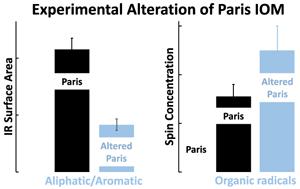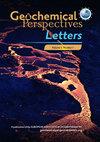reservation of the isotope signatures in chondritic IOM during aqueous alteration
IF 3.7
1区 地球科学
Q1 GEOCHEMISTRY & GEOPHYSICS
引用次数: 2
Abstract
Mighei-type carbonaceous chondrites (CM) figure among the most primitive objects in the solar system. Yet, they all have experienced various degrees of aqueous alteration having modified their insoluble organic matter (IOM), in a sequence that remains to be accurately constrained. Here, we exposed the IOM of Paris, the least altered CM available, to hydrothermal conditions at 150 °C for 49 days and compared the experimental residue to the IOM of two altered CMs likely originating from the same parent body as Paris, namely Aguas Zarcas and Mukundpura. The experimental residue shows a chemical and isotopic composition similar to those of Aguas Zarcas and Mukundpura IOMs, confirming that these CMs can be seen as altered counterparts of Paris. The abundance of organic radicals also increases significantly during the experiment. Isotopic hotspots do not seem to have been lost during the experiment, suggesting that the hotspots generally observed within the CM IOMs may date back from pre-accretion era. Of note, the Raman signature of the residue differs from that of the CM IOMs, highlighting the need for further experiments better mimicking asteroidal-like conditions.

水蚀变过程中球粒岩IOM同位素特征的保留
Mighei型碳质球粒陨石(CM)是太阳系中最原始的天体之一。然而,它们都经历了不同程度的水性蚀变,改变了它们的不溶性有机物(IOM),其顺序仍有待准确限制。在这里,我们将巴黎的IOM,即可用的变化最小的CM,暴露在150°C的水热条件下49天,并将实验残留物与两种可能来源于与巴黎相同母体的变化CM的IOM进行比较,即Aguas Zarcas和Mukundpura。实验残留物显示出与Aguas Zarcas和Mukundpura IOM相似的化学和同位素组成,证实这些CM可以被视为巴黎的改变对应物。在实验过程中,有机自由基的丰度也显著增加。同位素热点在实验过程中似乎没有丢失,这表明在CM IOM中通常观察到的热点可能可以追溯到吸积前时代。值得注意的是,残留物的拉曼特征与CM IOM的拉曼特征不同,这突出表明需要进一步的实验来更好地模拟类似小行星的条件。
本文章由计算机程序翻译,如有差异,请以英文原文为准。
求助全文
约1分钟内获得全文
求助全文
来源期刊

Geochemical Perspectives Letters
Earth and Planetary Sciences-Geochemistry and Petrology
CiteScore
7.00
自引率
2.00%
发文量
42
审稿时长
15 weeks
期刊介绍:
Geochemical Perspectives Letters is an open access, internationally peer-reviewed journal of the European Association of Geochemistry (EAG) that publishes short, highest-quality articles spanning geochemical sciences. The journal aims at rapid publication of the most novel research in geochemistry with a focus on outstanding quality, international importance, originality, and stimulating new developments across the vast array of geochemical disciplines.
 求助内容:
求助内容: 应助结果提醒方式:
应助结果提醒方式:


